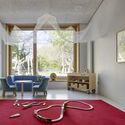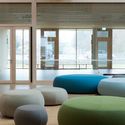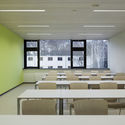
"And a window that looks out on Corcovado. Oh, how lovely." Tom Jobim's lyrics, immortalized by João Gilberto and Astrud Gilberto's voices and a soft guitar, was one of the early songs that introduced the world to the idea of a paradisaical Rio de Janeiro and a promising Brazil, with an increasingly urban population and a modern capital being built from nothing. Almost 60 years later, Paulo Mendes da Rocha casually quotes this song in an interview and points out that for him, in this scene, the most important element is the window, not Corcovado or Christ the Redeemer. That's because it frames the view and directs our eyes to what matters. It is a phrase that goes almost unnoticed, but that carries enormous poetic and artistic significance to the craft of architecture.
In addition to framing views, windows are elements of vital importance for almost any project. They facilitate visual communication between the outside world and an internal space while filtering light, insulating from cold and heat, blocking water, and even ensuring protection from intruders. Any architect will also agree that in addition to these essential functions, the aesthetics and materials of a window will make a brutal difference in the appearance of a facade or space. Furthermore, frames must meet specifications and follow local technical standards while simultaneously adapting to the needs of a project, affecting the window's dimensions, spacing, location, and even the types of opening. Especially for more severe climates, the complexity of the frame is often so impressive that its details could almost constitute works of art, with intricate fittings, folds, and pieces each playing an important role.

That is why choosing the type of window is such an important and critical part of a project. One of the first decisions concerns the material. Wood is almost universally considered a suitable material for interiors. The beauty of the veins, tones, and fittings, the feel of the fibers, and the warmth they emanate make wooden frames an effective option that brings both comfort and aesthetics to architectural projects. But when exposed to the elements, wood requires great care and becomes a somewhat complicated option to maintain. Mixing two materials is a good solution in many cases: while keeping the interior frame wooden, architects can choose windows that are aluminum on the outside, painted in the color and finish that the suits the project best. This combination is utilized in frames produced by Batimet, a German manufacturer of windows and facades made of wood and aluminum. With robust, yet delicate pieces, Batimet's different models can adapt to any design requirements.

When choosing the windows for a project there are several other issues to take into account. It is essential that architects pay attention to tightness, resistance to rain, wind load, sound insulation, and even to levels of security against burglary and fire. But there are also aesthetic design decisions that will make a difference in the project. These include whether the window surface will be flush with the facade or if it will be further back; whether the window frame will be visible or hidden; and even whether fixed or operable frames or a mixture of both will be used.
For example, in the Mensa Waldcampus project by andreas gehrke. architekt, the windows were kept flush with the facade through the use of frames and curtain walls. On the other hand, at the Ecumenical Forum HafenCity by Wandel Hoefer Lorch + Hirsch, identical windows were installed further back, following the organic pattern of the brick facade.



In the New Office and Lab Fraunhofer IPA project by Nickl & Partner Architekten AG, large rectangular glass panels were arranged in an alternating pattern on the façade, the frames barely noticeable. Conversely, in the project for a school in Dresden, the architects chose to highlight the frames, mixing operable and fixed parts in the same opening to form a regular checkered pattern.



In the case of the project for an office building in Berlin, the choice of opaque, transparent, and operable panels is what creates dynamism in the building's facade.


Being an expressive part of the overall building, the choice of windows for a project must be made very consciously. The ideal process of window designation is for manufacturers to contribute during the drawing and early planning phases, to assist in choosing the most appropriate models, details, and solutions. Ultimately, however complex, robust, or well-built they are, what we tend to look for most in window frames is that they go almost unnoticed in our daily lives. That is, they must function properly, prevent leaks, inhibit thermal losses, and avoid problems of handling or peeling. And while protecting us, they must continue to frame beautiful landscapes and connect us to the outside as well.
Find additional information here.
Related Articles


























